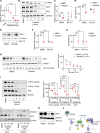Triptolide and its prodrug Minnelide target high-risk MYC-amplified medulloblastoma in preclinical models
- PMID: 38885332
- PMCID: PMC11290968
- DOI: 10.1172/JCI171136
Triptolide and its prodrug Minnelide target high-risk MYC-amplified medulloblastoma in preclinical models
Abstract
Most children with medulloblastoma (MB) achieve remission, but some face very aggressive metastatic tumors. Their dismal outcome highlights the critical need to advance therapeutic approaches that benefit such high-risk patients. Minnelide, a clinically relevant analog of the natural product triptolide, has oncostatic activity in both preclinical and early clinical settings. Despite its efficacy and tolerable toxicity, this compound has not been evaluated in MB. Utilizing a bioinformatic data set that integrates cellular drug response data with gene expression, we predicted that Group 3 (G3) MB, which has a poor 5-year survival, would be sensitive to triptolide/Minnelide. We subsequently showed that both triptolide and Minnelide attenuate the viability of G3 MB cells ex vivo. Transcriptomic analyses identified MYC signaling, a pathologically relevant driver of G3 MB, as a downstream target of this class of drugs. We validated this MYC dependency in G3 MB cells and showed that triptolide exerts its efficacy by reducing both MYC transcription and MYC protein stability. Importantly, Minnelide acted on MYC to reduce tumor growth and leptomeningeal spread, which resulted in improved survival of G3 MB animal models. Moreover, Minnelide improved the efficacy of adjuvant chemotherapy, further highlighting its potential for the treatment of MYC-driven G3 MB.
Keywords: Brain cancer; Oncology.
Conflict of interest statement
Figures








References
-
- Curtin SC, et al. Declines in cancer death rates among children and adolescents in the United States, 1999–2014. NCHS Data Brief. 2016;(257):1–8. - PubMed
MeSH terms
Substances
Grants and funding
LinkOut - more resources
Full Text Sources
Miscellaneous

